Feat platoon of Lieutenant Shironin. "Ukrainian Panfilov"
Leonid Bykov tried to shoot his war films using documentary material. For example, his famous painting “Only old men go to battle” was a compilation of real memories of combat pilots belonging to the period of the Great Patriotic War. Here and the history of the battle at Podbednya station looks similar to the history of the battle that occurred in March 1943 of the year near Kharkov. It was a battle platoon of Lieutenant Peter Shironin, which occurred 2 March 1943, on the outskirts of the village Taranovka. During the battle with the superior forces of the Nazis from the platoon, in which there were 25 people, 19 died, and 6 people were injured. Later all of them will be called Shironins by the name of their commander. 18 May 1943, all 25 men of the platoon of Lieutenant Shironin were awarded the title Hero of the Soviet Union. They also entered the story as “Ukrainian Panfilovs”.
In total, in the history of the Great Patriotic War, there are four well-known collective feats of Soviet soldiers. The most famous of them is the feat of 28 heroes of Panfilov (16 November 1941 of the year), the passions and disputes around which do not subside to this day. The second is the feat of 13 heroes of Krasnovka (January 15 1943), the third in a row was the feat of the Shironin guards - soldiers of the 1 squadron of the 8 company of the 78 guards rifle regiment of the 25 guards rifle division. This division was transformed from the 71 th naval rifle brigade to the 2 th guards rifle brigade, it was transformed into the 25 th guards rifle division in April 1942. A platoon of guard lieutenant Peter Shironin took an unequal battle with the superior forces of the Nazis 2 in March 1943 during the many days of fighting that Soviet troops fought over the village of Ternovka, Zmiivsky district, Kharkiv region. The last and also better known is the collective feat of 68 of the olshantse paratroopers of the participants of the Nikolaev marines 26-28 of March 1944, commanded by Marine Lt. Konstantin Olshansky, commander of a company of machine gunners. Following the results of that battle, 55 paratroopers were presented to the title of Hero of the Soviet Union.
The battle, which led a platoon of the guard Lieutenant Shironin, occurred on March 2, 1943. It is worth noting that from February 2 to March 3, 1943, Soviet troops conducted the Kharkov offensive operation. This operation was the third battle for Kharkov during the Great Patriotic War. Despite the fact that Soviet troops liberated the city on February 16, 1943, they again had to leave it. The Germans, pulling up reserves and focusing on the main direction of impact of the 2nd tank SS corps in the SS divisions Reich, Adolf Hitler and Dead Head, were able to turn the tide in their favor. Also, for a counterattack near Kharkov, Manstein attracted the 6th Panzer Division and the 320th Infantry Division in the main direction. It was with the tanks of the 6th Panzer Division that the platoon of Peter Shironin had to face the village of Taranovka, for which soldiers of the 78th Guards Regiment of the 25th Guards Rifle Division fought until March 11, leaving this settlement only on the orders of a higher command and retreating to new positions - the frontier of defense Chemuzhovka-Zidka. During this time, only the 78th Rifle Regiment lost 2/3 of its personnel in the battles for Taranovka, while the soldiers of the regiment covered themselves with unfading glory.
A great contribution to the reconstruction of the events of the day 2 March 1943 of the year and the famous platoon of guard Lieutenant Shironin brought Vokhmyanin Valery Konstantinovich and Paramonov Andrei Fedorovich, who devoted the book “Shironintsy: a feat without censorship” to this event. After the war, this battle was repeatedly described in newspapers, as well as books. At the same time, as often happened, information in all publications was confusing. One of the main mistakes, which still wanders from one publication to another, is the date of the battle. Quite often, the date of March 5 occurs, which is erroneous. The battle, in which Shironin's platoon was almost completely killed, occurred on March 2 of 1943, as evidenced by numerous documents, including the 25 Guards Rifle Division itself. The correct date - 2 March 1943 of the year - is contained in the award lists of participants in the battle.
The men of the 78 Guards Regiment with the 7 battery of the 53 Guards Artillery Regiment approached Taranovka at 8 in the morning of 1 in March 1943 of the year, taking up a defensive line, which was already partially prepared by the 179 tank brigade. The 1 th battalion of the regiment, which included the platoon of Shironin, from the 7 th batteries defended a road junction in the area of the Bespalovka station located on the southern edge of the village. In addition to the artillery battery, the 78 Guards Regiment was given two guns from the 29 Guards Fighter Anti-Tank Division and an engineer squadron of the 28 second sapper battalion, and also in Taranovka there was a machine gun platoon from the division's machine gun battalion. The engineer company, together with the sapper platoon of the 78 regiment, mined the approaches to the first and second crossings at Bespalovka station. They apparently didn’t have a shortage of mines, since after that they had a supply of mines in two lorries.
At the second crossing of the station Bespalovka, the command of the 78 Guards Rifle Regiment was located the combined platoon of Guards Lieutenant Peter Nikolayevich Shironin, which was composed of personnel of the 8 th regiment company. A platoon consisting of a 25 man and one 45-mm gun (commander of the gun - guard, senior sergeant Komarov, loader - guard private Petrenko) received a special task. After the war, this task always sounded the same: it was necessary not to let the tanks and infantry of the enemy pass through the crossing. Someone argues that the move had to be kept at any cost in order not to miss the German armored trains in the direction of Kharkov. At the same time, the composition of the platoon, as well as its combat equipment, does not give us reason to say that it should have played a significant defensive role. It was not a clearly defined anti-tank defense center, much less an anti-tank defense area.
In the opinion of modern researchers Vokhmyanin and Paramonov, a platoon of Shironin, whose positions were not located across, but along the railway leading from the south to the village of Taranovka, had to fulfill the role of a kind of “irritant” for the enemy. By their fire impact on the enemy, the Shironintsy had to force the Hitlerites to suspend advancement to Taranovka, deploy their battle formations in the direction of the platoon, while exposing the vulnerable sides of the tanks to the fire of the Soviet artillerymen and tankers located on the southern outskirts of Taranovka. At the same time, the soldiers of the Shironin platoon were trained and brave fighters, some of whom were marines hardened in previous battles, and the platoon consisted of many sergeants and squad leaders. Just because they did not intend to give up their lives, before the platoon positions were mined, there was also an agreement to conduct barrage of artillery fire not only by the regimental and divisional artillery, but also by the division of the rocket guard of the mortar (366-th guards mortar 87-th guards mortar the regiment was located in the farm Diptany).
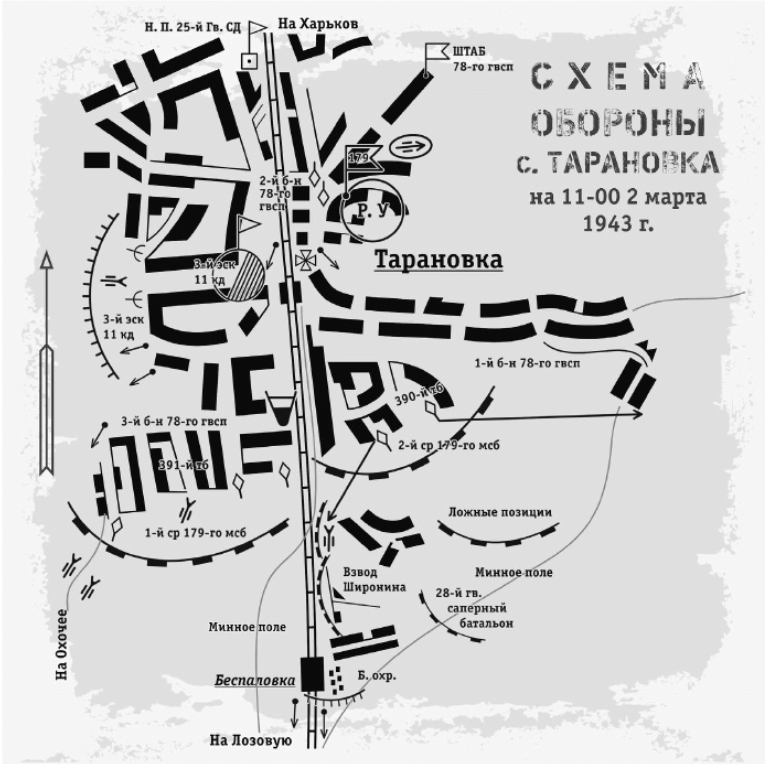
The battle that went down in history began around 11 in the morning on March 2 of 1943. This time is recorded in the evening combat report of the commander of the 25-th Guards Rifle Division, Major General Shafarenko from 18: 00 and later - in the operational report of the division headquarters from 23: 00. The same time is confirmed by the military report of the 179 tank tank brigade to the headquarters of the 3 tank army, the report was compiled in 14: 20.
How exactly the events of this day developed are described quite well in the memoirs of General P. M. Shafarenko. At 11 hours of the morning, the advanced patrol of the German 6 Tank Division, consisting of two armored vehicles and one tank, as well as a vehicle with infantry, appeared in the field of view of a platoon of guard Lieutenant Shironin. One of the German armored vehicles exploded at the mines installed in front of the platoon positions (it was a reconnaissance armored vehicle or a half-track armored personnel carrier difficult to say, since the commanders of the Red Army recorded all of them in their reports as armored vehicles), then the fire on the Germans opened “forty skater” sergeant Komarov she hit the second German armored car. After that, the tank and the dismounted motorized infantry opened fire on the positions of Soviet soldiers, but quickly moved back.
About half an hour later, more than 30 German bombers attacked the positions of the Shironin platoon and the rest of the Soviet forces defending Taranovka. During the raid, the commander of the 45-mm gun sergeant Komarov was killed, and the charging private Petrenko was seriously wounded. Instead of them, sergeant Sergey Nechipurenko and private Alexander Tyurin rose to the gun.
In 11: 30 was followed by the first attack of the enemy directly on the platoon position of Lieutenant Shironin. After the bombardment and shelling, the attack went to 10 German tanks and to the company of motorized infantry on armored personnel carriers. As soon as the enemy’s tanks deployed to attack the platoon positions, Soviet artillery opened fire on them, as a result one tank and one self-propelled gun were shot down. At the same time, the battle turned around at the second crossing, where the Germans tried to roll over the railway line and bypass the positions of the Shironin platoon. A self-propelled gun and two armored vehicles passed through the railroad tracks. One of them collapsed later under the ice, and the second was hit by artillery fire. A self-propelled gun that broke through to the rear crushed the Shiroponi’s “forty-five”, but was blown up by a bunch of grenades by Andrei Skvortsov, who himself also died. On this, the first attack on the platoon position of Shironin ended, in the platoon there were three killed and five wounded, the 45-mm gun was crushed.
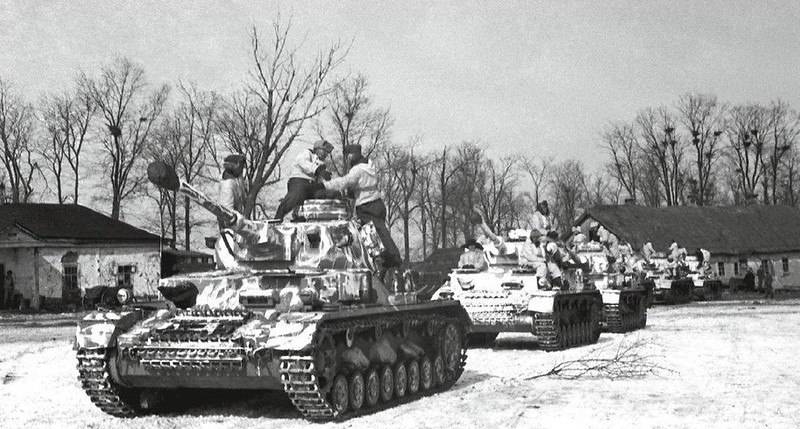
During the second attack on the positions of the platoon, the Germans were already better oriented on the ground and were able to more quickly overcome the distance to the positions of the Soviet troops. In this case, barrage artillery fire did not cause them much harm. In addition, the enemy realized that the positions of the Shirorin platoon are not basic. During this attack, the German tanks tried to attack the southern outskirts of Taranovka with the main mass, from which gunners of the guards and 179 tank brigade fired at them with direct fire. At the same time, in the positions of platoon guard Lieutenant Shironin, a hand-to-hand fight began. Obviously, this moment of battle for the platoon was the key. After completing their task, they could retreat to their main parts.
This battle was particularly difficult, the positions of the Soviet troops came to 12 tanks, 5 armored vehicles, self-propelled guns and to the regiment of motorized infantry. The Germans managed to press the infantry of the 78 Guards Rifle Regiment during the attack, after which the 179 I tank brigade was forced to counterattack the enemy. During the battle, the defenders of Taranovka destroyed 7 tanks, 2 self-propelled guns and 5 enemy armored vehicles. At the same time, the tank crews of the 179-th brigade requested additional ammunition, fuel and lubricants and asked for air cover, since the Germans made 11 unpunished sorties from the 67 in the morning to the position in Taranovka.
Approximately to 14: 00 2 March, March 1943, the platoon position of Lieutenant Peter Shironin’s platoon was left. Before that, a small group of infantry from the 1 battalion of the 78 Guards Rifle Regiment helped the Shironinians repel another German attack and remove the wounded from the battlefield. The operational report of the Chief of Staff of the 25 th Guards Rifle Division says that the battle at the Shironint positions was three hours from 11 to 14 hours. As a result of this battle, units of the 78 Guards Rifle Regiment destroyed 6 tanks and enemy 7 armored vehicles. Obviously, this is the result of the battle, which entered the history of the battle, which was fought by lieutenant Shironin with the support of the division artillery and the tank crews of the 179 tank armor.
If we talk about the losses suffered by the Wehrmacht 6 Panzer Division in that battle of 2 in March, it lost within three hours from 12 to 15 tanks and self-propelled guns and to 10 armored vehicles. They were undermined by mines, destroyed by barrage of artillery and guards mortars, anti-tankists and tank crews of the 179-th tank brigade. Accurate information about who destroyed many tanks and armored vehicles of the enemy is naturally not known. Some of the vehicles were definitely hit by grenades of the Guardsmen, as was the case with the self-propelled gun that crushed the 45-mm gun.
The award list of Shironin Pyotr Nikolayevich says that his platoon 2 March 1943 had to repel the attack of 25 tanks and armored vehicles and infantry of the enemy. In a bloody battle, the platoon fighters did not retreat from their positions on the southern outskirts of Taranovka, they shot down and set fire to grenades and incendiary bottles of 7 tanks and 4 armored vehicles, destroying up to fifty Nazis. In this case, the lieutenant himself was wounded three times. After recovery, he will be discharged and demobilized from the army as an invalid of the 2 group. He will return to his hometown, where he will continue to work on his main profession - he will teach children, in civilian life he will be the principal in his own Kirs.
The task of the platoon of Shironin was much simpler than described later. That does not detract from the feat of people who heroically fought in their positions almost to the last person. Moreover, the platoon of Shironin fulfilled his task in full. By their actions, they created favorable conditions for the destruction of as many enemy troops as possible with the available fire weapons in the very first hours of the battle for Taranovka. The Soviet troops imposed their initiative on the Germans from the 6 Panzer Division, forcing them to fight not according to their own plans, but according to their own plans.
The platoon of Guard Lieutenant Shironin, who was assigned to him the task, was practically fulfilled already in the first attack, taking advantage of the respite, the fighters could withdraw to the main line of defense of their regiment. To keep the move on their own, they would not have succeeded in any case; after three hours of battle, the entire regiment would step back a little, leaving the southern edge of Taranovka. Moreover, when the battle broke out directly on the platoon positions, the regimental and divisional artillery, which was afraid to cover its own, could not help them. However, no one left their positions. They were battle-hardened former marines, sergeants and sergeants, in whom there was a thirst for revenge for their dead comrades and a desire to sell their lives more expensively. It was this selflessness and heroism of the Shironinians that aroused the emotions that were described in the memoirs of the deputy commander of the 78 Guards Rifle Regiment for the political part of Major M.V. Pakhomov, who was directly watching the battle, and in the report to the regiment commander K.V. "This platoon repeats the Panfilov's feat."
As a result of the battle, 19 platoon soldiers were killed, the rest of 6 people, including Peter Shironin himself, were seriously injured. Guards Lt. Shironin, Guards Senior Sergeant Vernigorenko, Guards Private Bukaev, Isakov, Toropov and Tyurin survived the memorable battle. At the same time, Vasily Isakov died in the same 1943 year, but already in August, Alexander Toropov survived to the victory, but died in peacetime: 27 May 1946, in a battle with Bandera. The last of the Shironinites left Ivan Vernigorenko, he died in January 1984 in Kharkov at the age of 65 years, was buried in Taranovka along with the rest of the men of his platoon. Lieutenant Shironin died in 1968, at the age of 59, he was buried in his homeland.
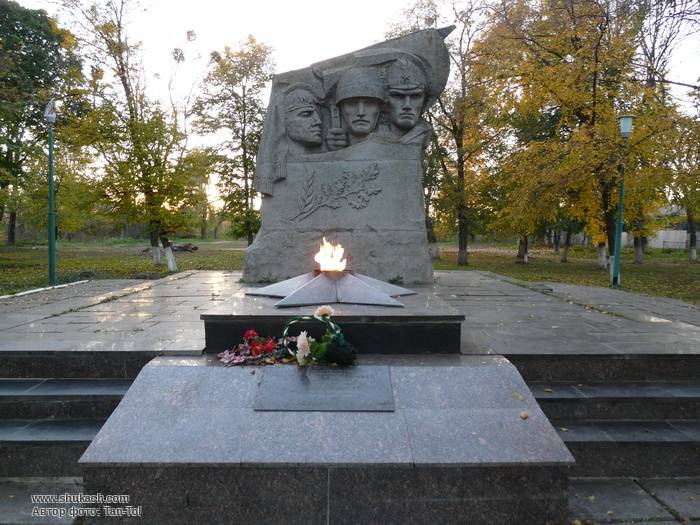
By the decree of the Presidium of the Supreme Soviet of the USSR from 18 in May 1943, the title of Hero of the Soviet Union was awarded to all 25 guardsmen of the platoon Peter Shironin. Initially, all of them were presented to the awards posthumously, and the lieutenant himself as of 25 in March 1943 was listed as killed and buried near the village of Taranovka, along with 19 the soldiers of his platoon who were actually killed in this battle.
After the war, the memory of the heroes of Shironintsev was immortalized. At the mass grave of heroes in the village of Taranovka, the Eternal Flame is set. The railway platform in the village of Taranovka was named “Shironino”. In memory of them in Kharkov, the street was named “Guardsmen of Shironintsev”. In addition, in the homeland of the heroes also established monuments in their honor. In the hometown of the guard, Lieutenant Peter Shironin (Kirs in the Kirov region), one of the streets is named after the hero, and in the local museum, the current exposition is dedicated to the countryman warrior.
Information sources:
V.K. Vokhmyanin, A.F. Paramonov. Shironintsy: feat without censorship. - X: Kharkiv private museum of city manor, 2014. - 120 S.: Il.
http://www.aif.ru/society/history/aty-baty_shli_soldaty_istoriya_boya_legshego_v_osnovu_filma
Open source materials
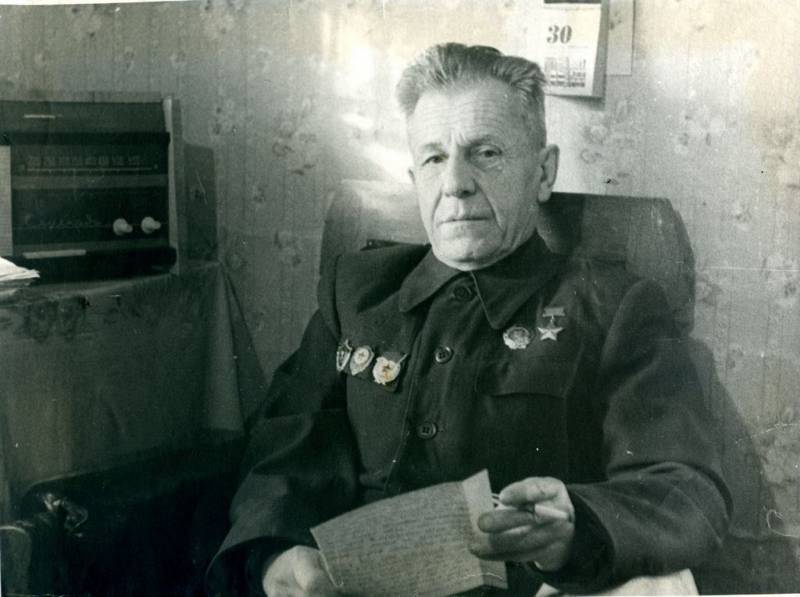
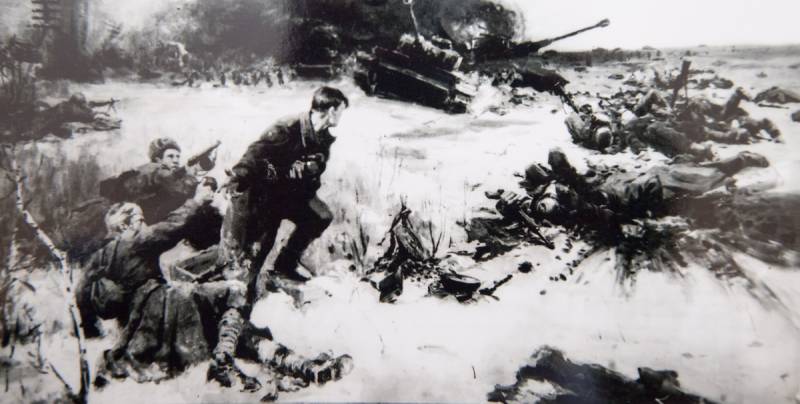
Information